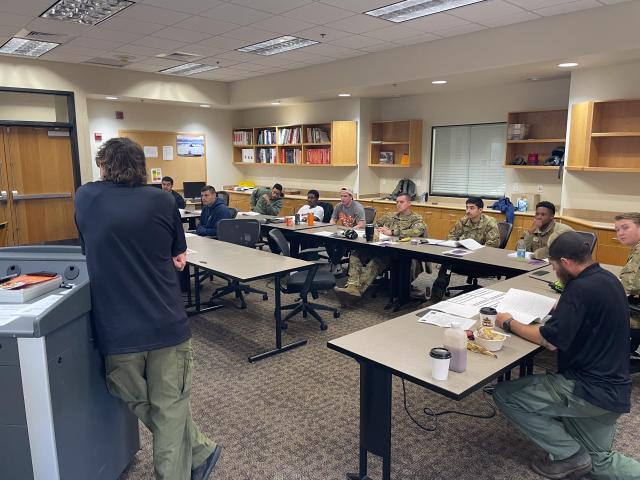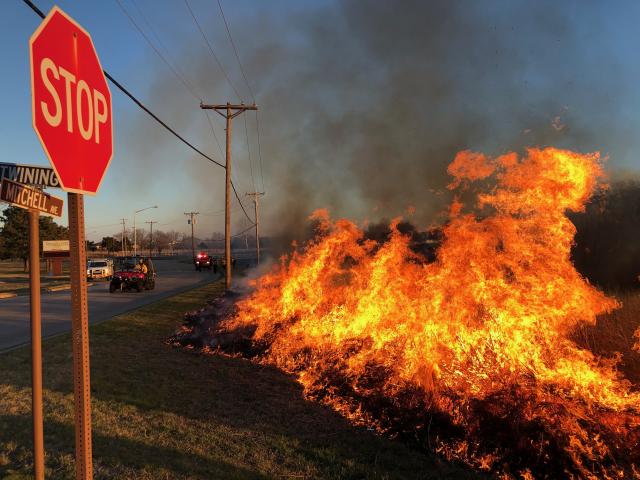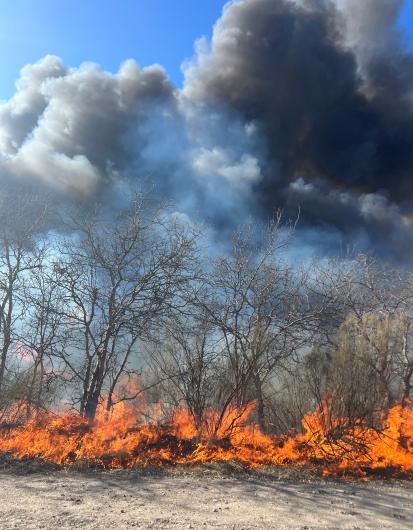Long-term partnership between BLM Fire and United States Air Force builds national firefighting capacity and accomplishes critical fuels work
The federal government is comprised of many dedicated public servants operating under diverse missions. When overlap exists or develops between those missions, it presents exciting opportunities for mutual learning through interagency partnerships. Such a partnership exists in the southern United States, where Bureau of Land Management (BLM) employees make up a United States Airforce (USAF) Wildland Support Module, whose areas of responsibility are USAF lands in Texas and Oklahoma.
The wildland support module was established in 2018, just six years after the establishment of the USAF Wildland Fire Branch in 2012. While the military may not be the first entity that comes to mind when we think of land management, the USAF has 8.5 million acres of developed and undeveloped lands under its domestic jurisdiction, and those lands are subject to the same modern concerns about increasing severity of wildfires and hazardous fuel loads as anywhere else. The BLM, with its long history of wildfire and fuels management, has an opportunity to provide expertise to this fairly new program, as well as to learn skillsets special to the USAF environment.

Niles Ludlow, a BLM Arizona Fuels Specialist, came on board as assistant module leader at the module’s inception, and became module leader in August of 2024. He takes pride in having been with the module from the start, and the fact that their third hire (after himself and the previous leader) is still with the module as well, now serving as the acting assistant module leader.
In addition to typical fuels module work such as performing prescribed burns and mechanical treatments, Ludlow and his team are responsible for teaching wildland firefighting courses to approximately 50 USAF employees every year, including USAF Fire and Emergency Services personnel as well as those employed in the USAF natural resource office.
“Teaching the Airforce firefighters is one of the biggest things we do, getting them qualified at a minimum as red carded, type-two firefighters,” Ludlow said. “Wildland fire is becoming more important and prevalent in their agency. We help ensure the NWCG [National Wildfire Coordinating Group] standards of instruction.”

The module often works in high-complexity environments, in very close proximity to urban areas. Last year, they did burns on the north end of San Antonio and in the middle of Oklahoma City. In 2025, they have already accomplished over 1400 acres of burning at Camp Bullis at their home base in San Antonio, and have numerous other projects planned for the spring and beyond.

When Ludlow carries out a fuels project, he utilizes his own crew (six people when fully staffed), USAF firefighters, and BLM Arizona firefighters that detail in for two-week windows. This allows many BLM employees to gain qualifications and maintain proficiencies in key prescribed fire positions with opportunities that may not exist at their home units, a crucial benefit to the agency. Projects are also supported by other USAF wildland support modules from across the country. At a recent project, Ludlow had representation from USAF wildland support modules from Colorado, South Dakota, New Mexico, and Louisiana. When leading such a blended of crews, Ludlow says, “It’s one team, one fight.”
The USAF provides the funding for the module, as well as 13 others like it throughout the United States, under the Sikes Act: Conservation Programs on Military Installations. Ludlow says that differences in mission do sometimes need to be navigated. His home base, for example, is a heavily wooded area. Were it BLM-administered public land, fuels work might be more extensive, but they are limited by how much they can do without hindering the primary, military mission of the jurisdiction. “Natural resources are vital on military installations, but mission comes first,” Ludlow says.
On the plus side, the Department of Defense ensures that the module gets what it needs, providing funds to stand up projects, fix or replace equipment, and more. The module also gets to do projects that are unusual outside of a military context. For example, bird airstrike hazard (BASH) burns reduce or eliminate vegetation in order to reduce insects and nesting habitats that attract birds, in turn reducing the risk of bird strikes to aircraft. In another example, pyrobox burns reduce vegetation in advance of airshows to ensure that the pyrotechnic displays do not accidentally result in wildfire starts.
USAF Wildland Support Modules like Ludlow’s serve as an excellent example of partnership between different federal entities that enhances the capacities of both. By sharing knowledge and resources, the USAF and BLM Fire operate with broader understanding and situational awareness in service of both of their missions, thus better serving the American public.

Rebecca Paterson, BLM Fire Public Affairs Specialist
Related Stories
- A day on patrol with BLM Arizona Ranger Rocco Jackson
- Celebrating volunteers across the Colorado River District
- Enhancing Wildland Fire Response: Modernizations to Wildland Fire IT
- BLM recreation sites available to all: Exploring accessibility on Arizona’s public lands
- Connecting Utah students to public lands careers
